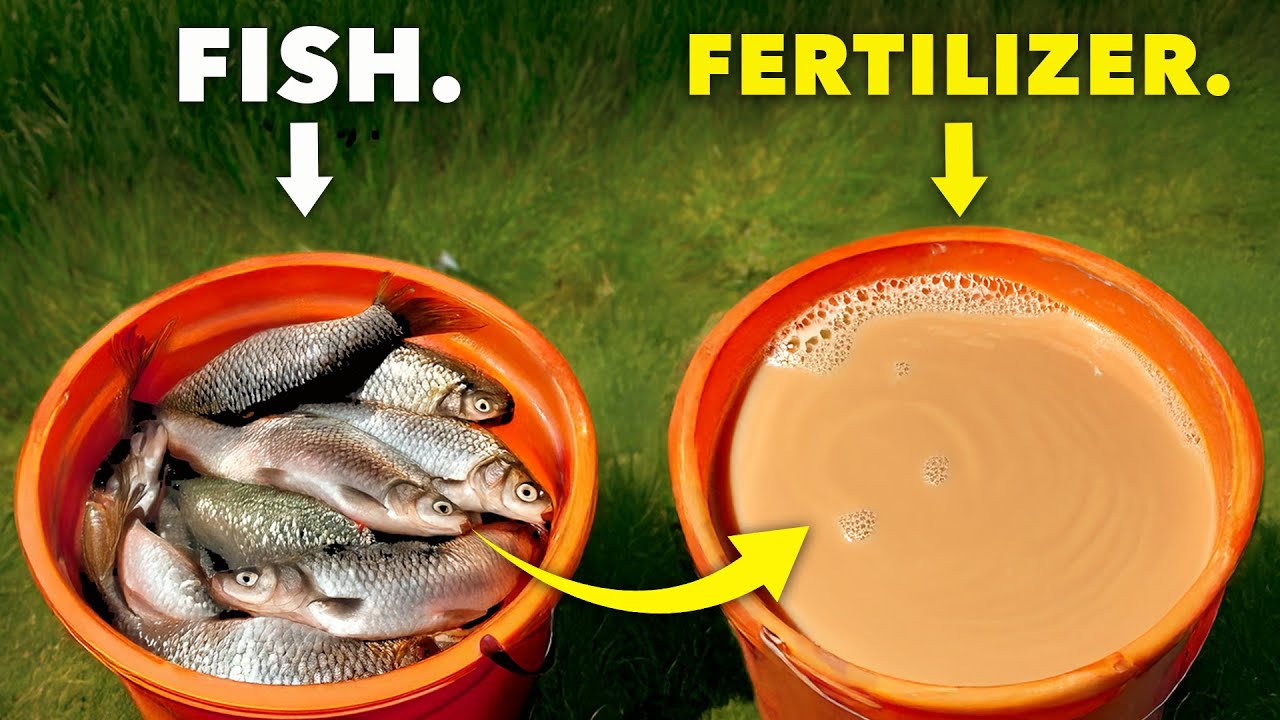Discover how you can create your own superior fertilizer using fish scraps—an eco-friendly and cost-effective alternative to Miracle-Gro. In this blog, you’ll learn simple methods to turn fish leftovers into nutrient-rich plant nourishment, giving your garden a natural boost while reducing waste.
Introduction
There’s a mischievous joy in turning kitchen scraps and garden weeds into a secret weapon for lush, thriving plants—much like the culinary alchemists of yore who believed magic lurked in their cauldrons. Welcome to the surprisingly pungent yet undeniably effective world of creating superior fertilizer using fish scraps. It’s a bit unconventional, sure, and might make your nose crinkle initially, but the rewards? Well, they’re worth the initial smell test. Imagine a garden where your leftover fish bones and garden weeds collaborate to produce a powerhouse fertilizer that outperforms even the flashy big-brand Miracle-Gro. No, this isn’t some urban legend; it’s a sustainable, organic revolution waiting to happen right outside your back door.
In a landscape cluttered with store shelves boasting shiny, chemical-laden solutions, the idea of relying on scraps and weeds may seem rustic—perhaps even daring. But here’s the twist: nature often knows best. This guide will navigate you through the process of making potent, eco-friendly fertilizer from leftover fish scraps, with plenty of tips, tricks, and sassy anecdotes. We’ll even share how to watch our quick video on making fertilizer from weeds for easy tips, and point you toward resources like a free garden planner and snippets from Ben’s beloved garden book. So, grab your apron, your garden gloves, and maybe a nose plug—your greener, healthier garden awaits.
Why Fish Scraps Are the Unsung Heroes of Fertilizer
Let’s face it: fish isn’t just a dinner guest—it’s an unspoken star on your garden’s roster. The reason? Fish scraps are bursting with nitrogen, phosphorus, and potassium—nutrients that plants salivate over like they’re at a five-star buffet. The bones, scales, and leftover bits are packed with mineral goodness that, when properly composted or soaked, release their bounty slowly and surely, feeding your plants the way nature intended. It’s like giving your garden a dietary supplement that is as natural as the morning dew but far more effective than synthetic fertilizers.
Moreover, using fish scraps is an elegant form of recycling; you’re turning what would otherwise be trash into treasure. Think of it as a small act of environmental rebellion. The mingling of kitchen waste and garden weeds in this process reduces landfill, cuts down on plastic packaging, and primes your plants for maximum growth without the harmful chemicals that come with many commercial fertilizers. Plus, there’s a certain satisfaction in knowing you’re harnessing life’s scraps—be it fish or weeds—to forge a stronger, healthier garden. This approach isn’t just eco-friendly; it’s downright inspired.
And don’t worry about the pong—yes, making fish-based fertilizer might be pongy but highly effective. The aroma is part of the process that signals the magic underway; it’s the smell of transformation. Next thing you know, your garden will be thriving, lush, and fragrant—an olfactory badge of honor proving that you’re a pioneer of sustainable gardening. Plus, with a few tips from our tutorial, you’ll learn how to make potent fertilizer from leftover fish scraps that becomes your secret weapon against stunted plants and poor soil. Think of it as your own botanical superfood—minus the expensive price tag and plus the thrill of DIY mastery.
Step-by-Step Guide to Making Fish-Based Fertilizer
Starting your fish fertilizer adventure might seem daunting, especially if you’re picturing a pot of stinky water fermenting on your patio. But fear not—this is a step-by-step process designed to maximize results with minimal fuss. Begin with collecting your fish scraps; bones, scales, and guts are all fair game. These bits should be placed in a bucket or a compost bin, and the magic begins when they start to decompose. You’ll want to add a touch of water—enough to submerge the scraps—and then cover the mixture securely. Think of this as giving your scraps a cozy, fermenting cocoon.
The secret ingredient in Ben’s garden for boosting plant growth comes into play here: the addition of weeds and organic waste to accelerate fermentation and nutrient release. Watching our full weed fertilizer tutorial can give you easy tips on how weeds can complement this process perfectly. As the days pass, the mixture will turn pongy—and this is normal, a sign that the microbial magic is cooking. You’ll notice a rise in the smell’s intensity, but don’t worry—this pungency is a sign of potent fertilizer in disguise. Regular stirring or turning helps distribute microbes evenly and speeds up the process.
Once the mixture has fermented for a few weeks—this depends on ambient warmth and your patience—you’ll strain out the solids, leaving behind a dark, rich liquid brimming with nutrients. This is the liquid gold you’ll feed to your garden, acting as a supercharged tonic for your plants. Remember, this isn’t a quick fix; it’s a labor of love that involves some effort, but the garden payoff? Overgrown, happy plants that seem to grow in fast-forward. Follow Ben’s advice for maximizing garden growth with minimal effort, and soon, pests and plant stress will be nothing but distant memories. Trust the process—it’s messy but tremendously rewarding.
Creative Ways to Use Fish Fertilizer in Your Garden
Having your fish fertilizer ready is like holding a winning lottery ticket. But the real magic is in how you use it. Pouring it directly onto the soil around your beloved tomato plants or pepper bushes is just the beginning. For optimal absorption, dilute your fish fertilizer—sometimes one part fertilizer to five parts water—before drenching your plants. Imagine the lush, vibrant greenery that results when plants drink up these nutrient-rich elixirs—they practically leap out of the soil, demanding less fuss and more fun in your gardening routine.
Experimentation is key here: you might discover that a weekly dose of this fishy brew catapults your garden’s productivity to new heights. Using this fish-based fertilizer to supercharge your garden’s productivity doesn’t always mean drenched in fish—though, let’s be honest, the pong can’t be avoided entirely. It’s worth it for the results: larger blooms, sweeter tomatoes, and a soil teeming with life. For those seeking a fuss-free approach, try the free Garden Planner available online to organize your planting schedule, ensuring each vegetable or flower gets its proper dose of this organic magic.
Remember, organic waste like weeds and fish scraps creates a natural symphony that benefits your soil and plants alike. This little eco-friendly ritual might raise eyebrows among neighbors or your skeptical spouse, but once they see those booming zucchinis and fragrant basil, they’ll be believers. If you have leftover fish scraps, learn how to make potent fertilizer from them—just be prepared for some pong. You’ll find that this fish-based fertilizer is not only sustainable but also incredibly effective at boosting plant growth, turning an odor into a badge of gardening honor. Follow Ben’s tips to maximize your garden’s potential—effort, patience, and a whiff of fish smell are your keys to success.
Frequently Asked Questions
1. How long does it take to make fish-based fertilizer from scraps?
The fermentation process typically takes anywhere from 2 to 4 weeks, depending on environmental conditions. Warmer temperatures speed up microbial activity, reducing the time needed for the scraps to break down into nutrient-rich liquid. During this period, the pungent aroma will intensify—a good sign that the microbial magic is working. Regular stirring or turning helps distribute microbes evenly, ensuring a faster nutrient release. Once the mixture turns dark and the smell stabilizes, it’s ready to be strained and used on your garden.
2. Is fish fertilizer safe for all types of plants?
Absolutely, but like all things good in life, moderation is key. Fish-based fertilizer is excellent for flowering plants, vegetables, and leafy greens, especially those craving high nitrogen levels. However, applying too much can lead to over-fertilization, which might cause leaf burn or overly lush foliage susceptible to pests. Always dilute your fish fertilizer before applying and observe how your plants respond. It’s a natural, versatile booster, but tailored application yields the best results.
3. Can I make fish fertilizer without a strong odor?
While some odor is impossible to escape—especially during fermentation—there are tips to minimize ponginess. Using a well-aerated container and fermenting in a well-ventilated area helps disperse smells. Adding organic waste like weeds or citrus peels can also help balance the aroma. Once strained and diluted, the odor diminishes considerably. Remember, the smell might be pungent but the results are fragrant and lush plants that thank you dearly. It’s a small price to pay for gardening greatness.
4. How do I store leftover fish fertilizer safely?
Store your fish fertilizer in a sealed container—preferably glass or heavy-duty plastic—in a cool, dark place such as a shed or garage. If you have more fertilizer than you need, keep it refrigerated, and be sure to label it clearly. Use within 6 to 8 weeks for best freshness; after that, microbial activity can diminish, and the smell may get worse. Always give your stored fertilizer a gentle shake before use, and avoid exposing it to direct sunlight to preserve its potency.
5. Are there any plants that dislike fish fertilizer?
Most garden plants enjoy fish fertilizer, especially nitrogen-hungry crops like tomatoes, peppers, and leafy greens. However, plants like basil or herbs that prefer lower nitrogen levels might require more diluted applications or alternative fertilizers. Also, be cautious with delicate flowering plants or newly planted seedlings—too much fertilizer at once can cause stress. Tailoring your approach based on plant type ensures healthy growth without any unwanted surprises.
Final Thoughts
Transforming kitchen scraps and garden weeds into a biological marvel like fish-based fertilizer isn’t just for the eco-conscious; it’s an act of rebellion against the chemical clutter of modern gardening. It’s about forging a genuine connection with nature—honoring the cycle of life that sustains us all. The pungency, the effort, the occasional eyebrow raise—it all adds to the story of a gardener who practices patience, sustainability, and a pinch of eccentricity. And in that chaos, your garden will flourish, blooming brighter and more resilient than ever imagined.
Whether you’re watching our full weed fertilizer tutorial or experimenting with leftover fish scraps, remember: the secret ingredient in Ben’s garden isn’t just nutrients; it’s a passion for living harmoniously with the earth. So go ahead, get dirty, get a little pongy, and enjoy the journey of creating a garden that’s not just beautiful but brilliantly sustainable. Here’s to greener days, richer soil, and the small triumphs of turning trash into treasure—one fish scrap at a time.

